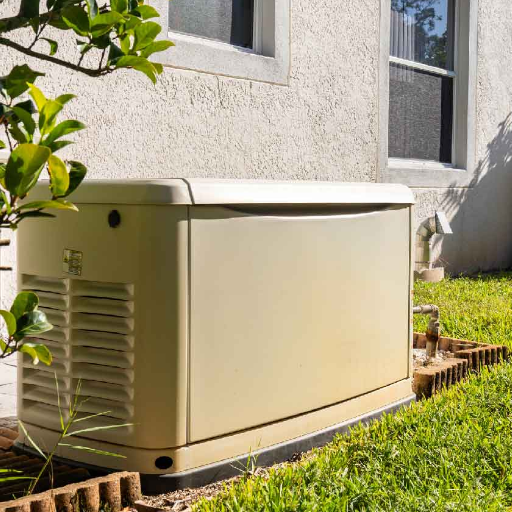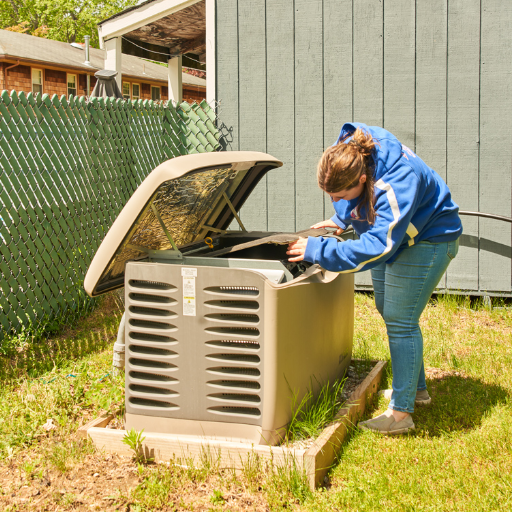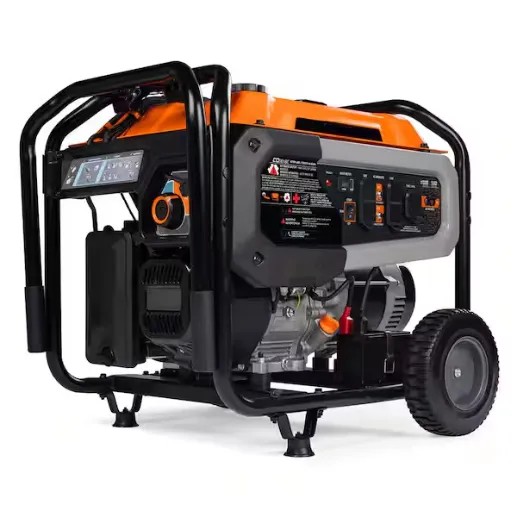Investing in a home generator system is a surefire way to ensure you have both peace of mind and practical solutions if the power goes out. The cost of the generator will be the main aspect homeowners need to consider, whether they’re thinking of a whole-house generator that ensures continuous power or a standby generator that powers only the most essential appliances and systems. This article will examine all the vital factors identifying the various costs of the generators. It will rate them from the most influential to the least essential compliances, thereby helping you make a well-grounded and budget-friendly decision based on your own needs. One can expect and decide on a home generator system that is appropriate.
What is a Home Generator?
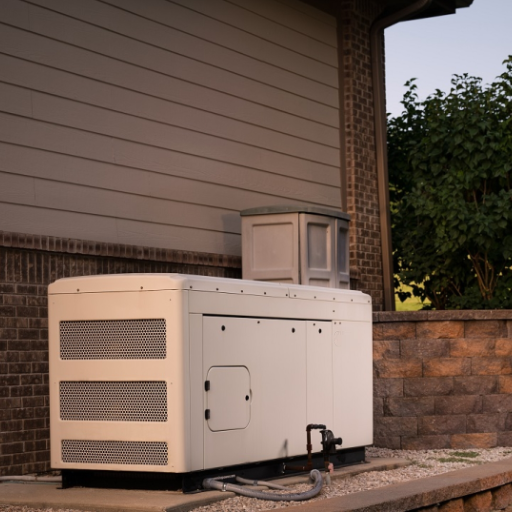
A home backup generator is a hidden power supply scheme that can take over when the primary power source fails. It’s typically designed to keep the lights on and the power flowing for the HVAC unit, refrigerator, medical devices, and even life-support systems when the power goes off. Home generators can be moved around or made permanent. They are usually linked into a house’s electrical system and run on fuel types such as natural gas, propane, or diesel. They are a reliable solution for power outages, addressing comfort and safety needs.
Types of Home Generators
| Type | Power Source | Portability | Usage | Noise Level | Maintenance Needs |
|---|---|---|---|---|---|
| Portable Generators | Gasoline/Diesel | High | Temporary power, outdoor use | Moderate-High | Regular refueling required |
| Standby Generators | Natural gas/Propane | Low (Permanent) | Whole-house backup | Low | Periodic inspection |
| Inverter Generators | Gasoline | Moderate | Sensitive devices, camping | Low | Ensure proper ventilation |
| Solar Generators | Solar panels/Battery | High | Eco-friendly, outdoor use | Silent | Battery maintenance |
| Battery Backup Systems | Battery | Low (Fixed systems) | Small appliances, low energy | Silent | Battery replacement |
Benefits of a Whole Home Generator
Reliable Power Backup
The whole house generator provides uninterrupted power to the utilities, allowing the residence to operate without interruption. In this scenario, you might not even have electricity problems to keep your devices, such as HVAC, refrigerators, lighting, and medical equipment, functional and easy to operate.
Automatic Operation
It is equipped with automatic transfer switches, which are designed to detect power interruptions and start up the generator in mere seconds. This effectively eliminates the need for someone else to interfere and ensures the immediate return of power.
Fuel Flexibility
Most compact households use natural gas or propane, which provides the advantage of an undisturbed fuel source. This means one will not need to bother with refueling, utilizing the standard, dirty gasoline or the more expensive diesel.
Protection for Sensitive Electronics
These champions of modern technology and innovation provide clean power that is free from the sudden excessive or low voltage events – these are the power problems that may otherwise damage the devices – this is the power they deliver to the most power-loving toys of the journey, like the computers, communication gizmos, and home automation systems.
Enhanced Home Security
Suppose the weather has been terrible and the power outage is prolonged. In that case, the security systems’ comforts, such as alarms, security cameras, and electric locks in your absence, can still be maintained with the help of a trustworthy generator.
Comfort During Extreme Weather
The permanent generator keeps your heating, ventilation, and air conditioning system working even in very hot or cold weather, hence maintaining the comfort and safety of your place.
How a Standby Generator Works
A standby generator is a reliable, autonomous power solution that automatically activates when there is no central power supply. It is directly connected to the house electrical system and fueled by either natural gas, propane, or diesel. When there is an outage, the transfer switch in the generator works uninterruptedly to get the power load from the utility line to the generator. At the time of the restoration of utility power, the system will revert to its original state, reconnecting your home to the grid and stopping the generator. The up-to-date standby generators are efficient in design, and some have been equipped with advanced technologies. This allows users to remotely monitor the performance and maintenance needs of the installation through mobile apps or other digital interfaces. In the meantime, the system users need to do nothing since they run automatically and provide a home with a constant power supply without manual involvement.
Generator Cost Breakdown
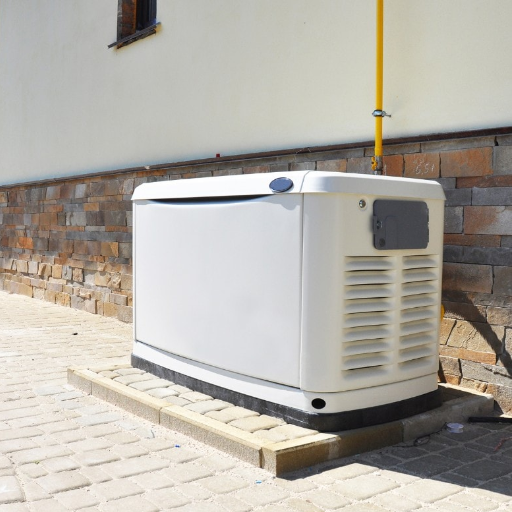
The overall price for a reserve generator is usually in the neighborhood of $2,000 to $20,000, depending on the size, brand, and facilities. Those of partial home coverage that are of less power are on the low end, while those of full house power are on the high end. The cost of installation varies and generally is found to be in the range of $3,000 to $5,000. In addition, maintenance should also be considered, as it can be expensive; the average cost for service per year is about $150 to $300. For the owners of the house, they should not only take into account prices but also other aspects such as warranties, efficiency of fuel and generator’s long-term reliability when choosing.
Average Cost of Whole House Generators
The cost of purchasing and installing a whole-house generator can amount to $10,000-$20,000 on average. The most significant factors affecting the overall price tag are the size and type of the generator. e.g., A small unit built with lower power will be nearer to $7,000, while a big one capable of covering a large house may get well over $25,000. As for installation, it has to do with things like site preparation, electrical wiring, and a transfer switch that are usually billed for $3,000 to $5,000 (combined). Moreover, the type of fuel the generator uses — natural gas, propane, or diesel —can also affect the costs and the total amount spent. Nonetheless, the advantages of a whole-house generator in terms of reliability are considered. As the installation cost cannot be estimated, the expense can range from $0 to $ 10,000 throughout the year, depending on the property.
Factors Influencing Generator Cost
A combination of factors, such as size, brand, installation difficulty, and fuel type, primarily influences the cost of a whole-house generator. Through KW measurement, the generator’s size is particularly connected closely with the power supply to the user’s house. Small, KW-rated consumers that can be relied upon for systems of the most critical nature are usually less expensive than the larger ones capable of servicing the entire house. Moreover, the company name remains a key factor as well, with the big players in the industry usually pricier due to reasons such as quality, dependability, and guarantee.
Installation complexity is one more critical point to address. Houses that need a lot of wiring changes or several transfer switches could end up paying more in relation to the installation cost. It can also happen that the placement of the generator would lead to higher prices. For example, if it is installed in tight or difficult-to-reach spaces, labor costs would surge. Also, the type of fuel can influence both the initial and running expenses. For example, natural gas or propane-powered generators are usually less expensive to operate over the years than diesel-powered ones; however, environmental and safety regulations, along with associated costs, are deterrent factors.
Moreover, a regular maintenance scheme and an extended warranty package must be seen as additional expenditures. Routine checkups will keep your unit in its best shape and avoid major breakdowns that could cost you a lot of money. On the other hand, extending the warranty period will relieve the homeowner from the worry of additional expenses for repairs that suddenly emerge. All these factors combined still require the assistance of someone in the house to observe the situation and make the right choice, as the investment is significant.
Comparing Generac and Kohler Home Generators
| Key Parameter | Generac Home Generators | Kohler Home Generators |
|---|---|---|
| Power Output Range | Up to 150kW | Up to 150kW |
| Fuel Options | Natural gas, propane | Natural gas, propane |
| Noise Levels | 60-70 dB (approx.) | Around 69 dB (approx.) |
| Warranty Coverage | 5 years standard | 5 years standard |
| Remote Monitoring | Mobile Link app | OnCue Plus app |
| Maintenance Frequency | Annually or after 200 hours | Annually or after 150 hours |
| Pricing Range | $2,000–$15,000 | $3,000–$20,000 |
| Durability Standards | Aluminum or steel enclosures | Corrosion-resistant enclosures |
| Starting Mechanism | Automatic transfer switch | Automatic transfer switch |
| Customer Support | 24/7 support | 24/7 support |
Installing a Whole Home Generator
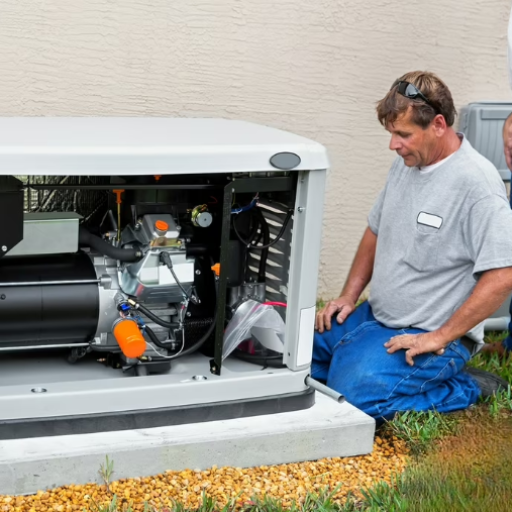
1. Site Selection
Select a safe and proper place for the generator. The unit must be placed outside, at least 5 feet away, on a hard surface such as a concrete or gravel pad. Make sure it meets with local regulations and the manufacturer’s recommendations, also.
2. Professional Installation
Task a qualified electrician or a facilitator to install for you. The technician will connect the generator to your home’s electrical system through an automatic transfer switch, ensuring a smooth transition during power outages.
3. Permits and Inspections
Do your homework by studying the local municipal codes and securing the required installations. There might be a need for a final checkup after the configuration to check if it is in line with safety standards.
4. Fuel Source Connection
Link the generator to the primary fuel source, which is typically natural gas, propane, or diesel. The fuel supply line has to be secure and sufficient to keep the generator running for an extended period.
5. Testing and Maintenance
After the installation, when the generator is started and running, we still need to do a test to confirm that it works. To keep it in peak condition, it is advisable to have an annual maintenance or service session after specific periods (such as 150 to 200 hours of operation).
Installation Process Overview
The initiation of a standby generator is a primary stage in guaranteeing a power supply that would not be affected by power outages. The job will begin with selecting the location, ensuring compliance with local zoning laws, and following the manufacturer’s guidelines to avoid buildings and ventilation points while maintaining a safe distance. To prevent the generator from moving or shaking while in operation, it has to be placed on a secure base such as a concrete pad.
This installation’s most complex parts are the hookups of electricity and the generator with fuel sources. The electrical hookup should be handled by a certified electrician who connects the generator to a transfer switch, enabling a smooth transition from utility power to the backup system. Also, establishing a safe-to-use fuel line is a condition for connecting the generator to the fuel source, whether it be propane, natural gas, or diesel. A choke in the system caused by an undersized fuel line will cause the generator to shut down constantly and may even shorten its lifespan.
It is essential to have a regular maintenance program for the generator. Most often, automated systems have self-testing features; however, they should not be relied upon entirely. Manual tests must also be conducted occasionally to find and correct any weak or missing spots in the system. Moreover, the worldwide figures go to prove that a regular servicing of a generator, i.e., oil and filter changes and load testing, among others/procedures, will surely prolong its life for 20 years at least, hence the necessity of following the manufacturer’s maintenance schedules, is one of the factors that influence the repair of generators.
Estimated Installation Costs
The price of installing a generator can range from cheap to very expensive, depending on the type of generator, its capacity, and the difficulty of the installation. Average homeowners can expect to spend anywhere between $3,000 and $7,000 on their standby generator installation, which includes not only the materials but also the vendors. Portable generators are usually comparably cheaper in terms of installation costs, with average prices between $500 and $2,000. Additional fees vary, for example, depending on the need to upgrade electrical panels, whether permits for installation are required, or the connection of the fuel line. Installation companies often encourage homeowners to seek multiple offers from certified professionals to ensure that both the price is competitive and the installation is set up properly. By being careful in preparing the install and budget, homeowners can choose an option of installation that is able to meet their electricity requirements and at the same time meet their financial plans.
Choosing the Right Generator Size
When the right size of the generator is chosen for the place of residence or business, it is essential to clarify the total wattage needed to operate the core devices and equipments during the power cut. It must be done by practicing the list of principal things — refrigerators, heating, air conditioning, lighting, and medical devices, and then calculating their total wattage. Normally, generators are once by their running wattage and also the more so the surge wattage capacity — that one is the measure for the short-term high in power when the appliance is being initially started. Responding to the needs of small households that are limited to the basic standard energy, the generator that falls within the wattage range of 5,000 to 7,500 would be enough. Bigger houses or businesses that have numerous high-performance appliances may necessitate the use of models that range between 10,000 to 20,000 watts or higher. It would be a good idea to go for a slightly higher than your calculated demand generator, which will leave room for the unexpected power needs and therefore secure the performance of the device. Inquiring with a certified electrician if it is the right size and being within safe limits is a good idea.
Understanding Generator Fuel Types
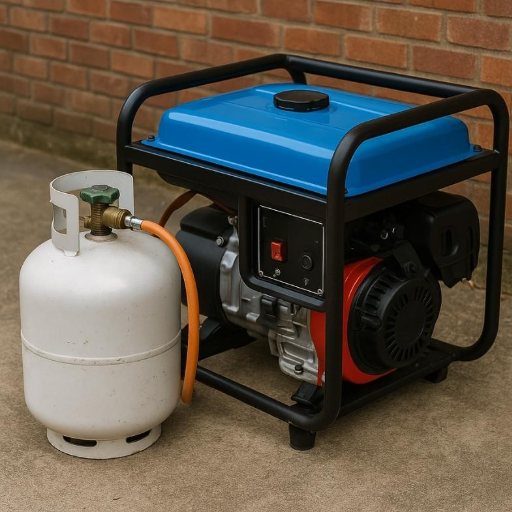
- Gasoline: The use of gas as fuel for portable generators is widespread, as it is widely available and very simple to operate. Nevertheless, this fuel has a comparatively as well as very large shelf-life. That is why, when used continuously for some time, the generator becomes less effective.
- Diesel: Known for its efficiency and robustness, Diesel is the best choice for high-capacity generators. It can support a greater capacity of demands for the load time, but will be more expensive and not as pollution-free as compared with other sources.
- Propane: One of the best things about propane is that it is clean-burning which makes it a great and viable option for standby and portable source of power as well as it has a long shelf life. Propane is usually kept in tanks, and it has a lower energy density than gasoline or diesel.
- Natural Gas: For houses that have the advantage of being connected to the natural gas lines, it is an excellent choice. It is a source of energy that is constant and clean, but not always the best for the use of portable generators.
Pros and Cons of Each Fuel Type
| Fuel Type | Pros | Cons |
|---|---|---|
| Gasoline | Widely available | Short shelf life |
| High energy density | Highly flammable | |
| Affordable upfront cost | Produces more emissions | |
| Diesel | Efficient and long-lasting | Noisy operation |
| Lower fuel consumption | Risk of gelling in cold weather | |
| Readily available in most areas | Higher initial generator cost | |
| Propane | Clean-burning | Lower energy density |
| Long shelf life | Requires large storage tanks | |
| Reliable and efficient | Higher fuel costs | |
| Natural Gas | Convenient for connected homes | Less portable |
| Unlimited supply via pipelines | Susceptible to supply interruptions | |
| Cleanest burning of all fuels | Lower energy output than gasoline/diesel |
Impact on Overall Generator Cost
The decision about the generator is determined mainly by two factors: the buying price and fuel cost. Gasoline and diesel-powered generators are generally cheaper to buy, but they are far more expensive in the long run, mainly because of the fluctuating price of fuel. However, in the case of propane and natural gas, consumers could expect a different pattern: a higher initial cost but running on a more stomach-friendly fuel. In the case of natural gas, there is also the potential for homes supplied through municipal pipes to never experience breaks in supply. Additionally, the needs of service and the scale of the economy are also considered when customers are evaluating their future costs. Surely, investing in efficient energy power stations can be a good choice because, although they may be more expensive initially, the long-term profits can be much higher. Therefore, people must continually evaluate every detail before making a final decision.
Evaluating the Worth of a Home Generator
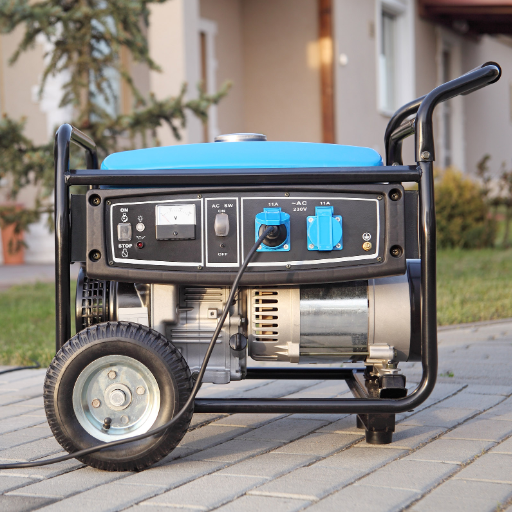
Before deciding whether a home generator is a suitable investment, you should consider three main factors: the reliability of the generator, the cost of the generator, and the customer’s basic needs. If you have power during the crisis, it will provide comfort, as vital appliances like fridges, heaters, and other things will be operating. As far as the cost is concerned, the first-year fee should be such that it does not exceed the potential savings for the rest of the years. This includes the cost of food that will spoil and losses due to disturbances in remote work. Furthermore, it is recommended that you check the special requirements of your place before you even think of buying a generator. Common examples include experiencing a high-frequency power outage or living in areas susceptible to the effects of natural disasters. Scrutinize these factors to understand whether a generator is the correct item for your lifestyle and budget.
Is a Home Generator Worth the Investment?
It can be an excellent idea for those living in areas prone to power interruptions to get a home generator. In fact, standby generators with recent technology are designed to restore electricity quickly and without a glitch, thus keeping your home running during blackouts. Statistics from industry studies indicate that experiences of continuous power failure are becoming increasingly frequent due to aging infrastructure and more severe weather conditions. A trustworthy generator is a means of recreating crucial parts of the house, such as heating, air conditioning, and medical equipment, in case of a supply cut-off.
A report by the professionals in the energy field is the source of the following information: financial loss due to outages could have been avoided if the food had not been spoiled, the pipes had not been frozen, or the work had not been lost as a consequence of the time that home generators were needed. The fuel consumption of a generator, unlike in the past, has significantly improved thanks to recent advancements in generator technology. This allows one to save on substantial maintenance costs and easily own a generator, which is more cost-effective. There are also reports attesting that a generator installed at a property could significantly increase its value, making it perfect for a buyer who invests in peace of mind during emergencies.
However, choosing correctly does mean that one has to cater to one’s particular needs. The first things to consider are how often and for how long you lack a power supply, as well as the household’s dependency on electricity or financial constraints. Renewable energy is not for everyone; nonetheless, its benefits might be pretty appealing to those for whom energy security and continuity are top priorities.
Long-Term Savings and Benefits
The purchase of a home generator can be a very beneficial deal and a source of significant advantages for the owners. Generators not only ensure a consistent power supply but also efficiently save the possessor from the hassle of potentially exorbitant costs caused by outages, whether they involve unrefrigerated food, frozen pipes, or home security systems literally dropping their guard. Moreover, the new generation of generators is designed to use less fuel, thereby significantly reducing the overall cost of operations. Some units can even work with renewable energy, making them a completely eco-friendly solution while also reducing dependence on the grid. All these factors, along with the increased comfort and trust these units offer, have slowly but surely been compelling many households to choose home generators as an economically and practically feasible option.
Reference Sources
Low-Cost and Energy-Efficient Alternatives for Home Automation using IoT
Key Findings: This study explores the integration of IoT technologies to create low-cost and energy-efficient home automation systems. It highlights the accessibility of these systems for families and their ability to integrate with platforms.
Optimization of energy consumption in smart homes using firefly algorithm and deep neural networks
Key Findings: This paper examines the use of advanced algorithms to optimize energy consumption in smart homes. It discusses the cost implications of photovoltaic (PV) systems and their role in reducing energy expenses while enhancing home energy management.
Frequently Asked Questions (FAQs)
How much does a whole-house generator cost?
Usually, the price for a whole house generator ranges from $7,000 to $20,000, depending on the size of the generator, its brand, and installation requirements. Companies like Kohler and Generac have a range of models that suit different budgets and needs. Entire home value, as well as the specific systems one is going to support, should be taken into account when considering generator cost. Such backup support will be, for example, the air conditioner, sump pump, and other home systems that will require reliable power during the outage.
What factors affect the total cost of a home generator system?
The entire system’s expenses can be influenced by several factors, including the generator size, the generator’s fuel type, the complexity of installation, and the particular requirements of the entire home. Consequently, aside from a diesel generator, a gas generator might have different installation costs. Also, an additional point to consider is the fuel prices and efficiency, which determine the cost of running a generator. Not to mention, the costs of permitting and the regular maintenance of the generator are also significant. These contribute to the total costs of the backup power supply, which is a substantial investment. You need to view all these factors from a macro perspective.
Are there any generator installation costs I should be aware of?
Obviously, the expenses of the generator installation might include labor costs, the electrical work done, and the acquisition of any required permits. The total charges for a home generator installation can vary significantly; it largely depends on how strictly local regulations are enforced and the type of property involved. The wise thing is to call a couple of licensed professionals to give you a price that is close to the real one. Besides, the other side of the coin is that if you are considering a more comprehensive power solution with a whole-home generator, it becomes essential to have the generator sizes and home systems’ layout evaluated for the most cost-effective installation.
How do I determine the right size generator for my home?
Before you can decide on the proper whole-home generator, you need to check the overall power requirement of the systems you will keep running during an interruption. This list may include essential household electronics, particularly refrigerators, air conditioning systems, and sump pumps. The generator selection for this case usually starts with the 5kW unit and may go up to 20kW, where the bigger generator will then be able to power more systems. It is an excellent idea to consult a professional who can help you match your household’s power needs and choose the right generator that provides utility at a low cost. Remember also to consider any future power enhancements, which might increase your power requirements.



